Kingdom Plantae Family Asteraceae Tribe Heliantheae Scientific name Helianthus annuus Higher classification Sunflowers | Order Asterales Subfamily Helianthoideae Genus Helianthus Rank Species | |
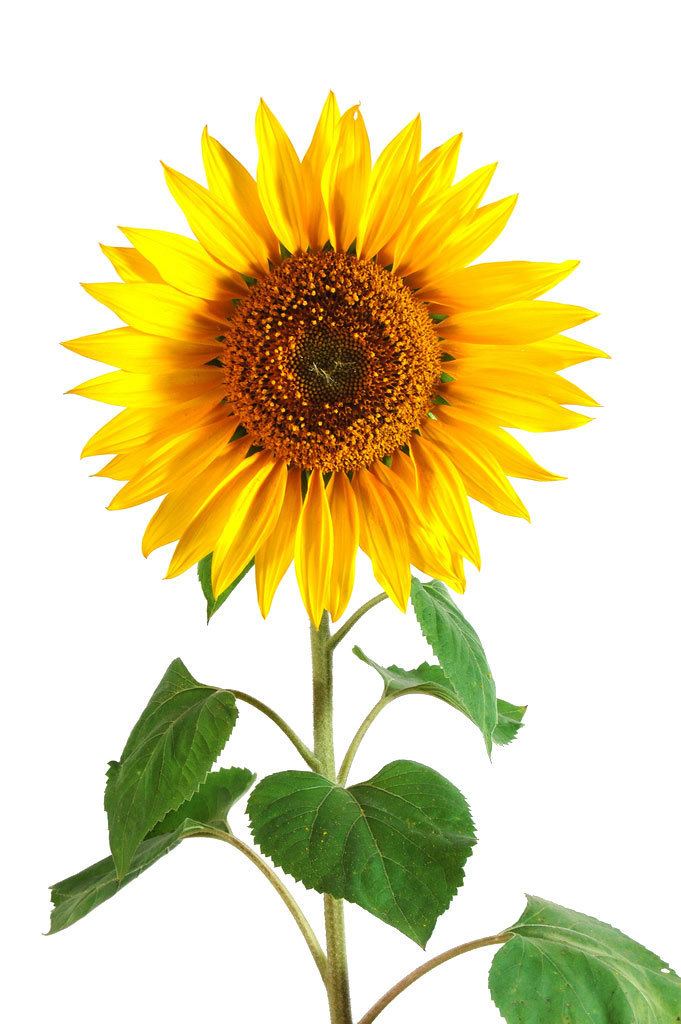 | ||
Similar Sunflower seed, Sunflower oil, Seed, Rapeseed, Soybean | ||
Sunflower helianthus annuus plant video wonder flower
Helianthus annuus, the common sunflower, is a large annual forb of the genus Helianthus grown as a crop for its edible oil and edible fruits (sunflower seeds). This sunflower species is also used as bird food, as livestock forage (as a meal or a silage plant), and in some industrial applications. The plant was first domesticated in the Americas. Wild Helianthus annuus is a widely branched annual plant with many flower heads. The domestic sunflower, however, often possesses only a single large inflorescence (flower head) atop an unbranched stem. The name sunflower may derive from the flower's head's shape, which resembles the sun, or from the impression that the blooming plant appears to slowly turn its flower towards the sun as the latter moves across the sky on a daily basis.
Contents
- Sunflower helianthus annuus plant video wonder flower
- Flower gardening tips how to grow common sunflower helianthus annuus
- Description
- Mathematical model of floret arrangement
- Genome
- Cultivation and uses
- Heliotropism misconception
- History
- Culture
- Cultivars
- Other species
- Sunflower hybrids
- Threats and diseases
- References
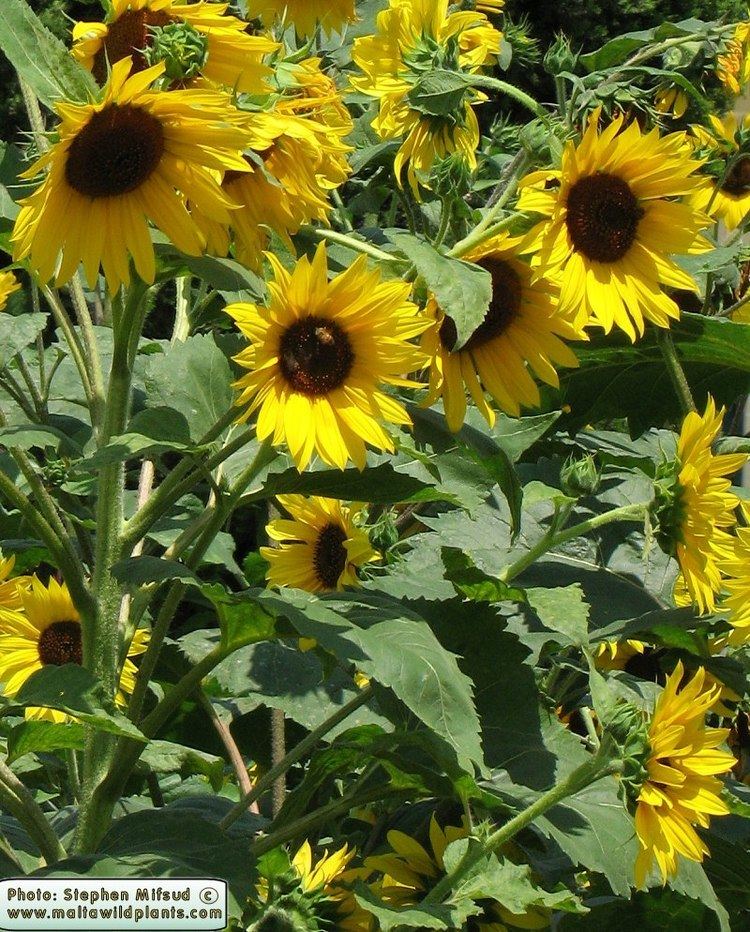
Sunflower seeds were brought to Europe from the Americas in the 16th century, where, along with sunflower oil, they became a widespread cooking ingredient.
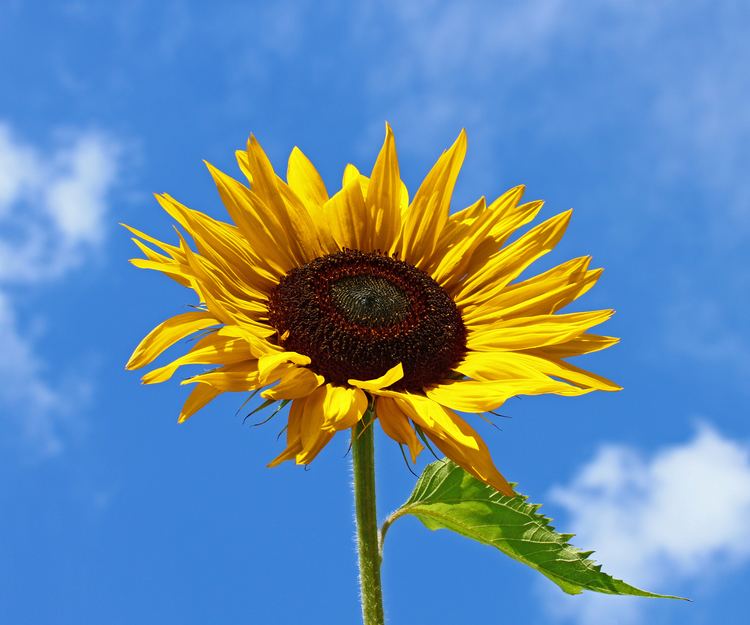
Flower gardening tips how to grow common sunflower helianthus annuus
Description
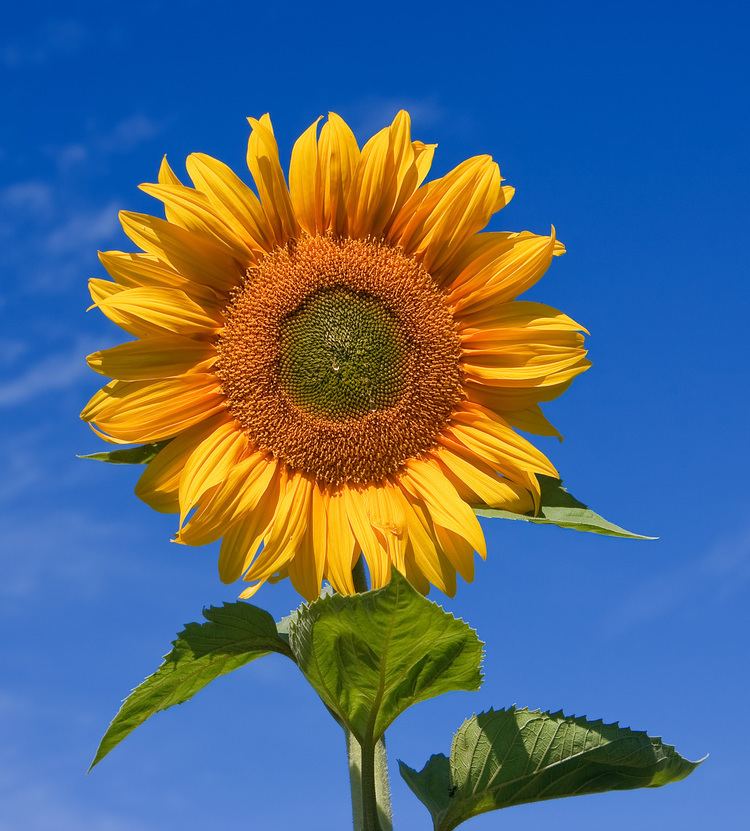
The plant has an erect rough-hairy stem, reaching typical heights of 3 metres (9.8 ft). The tallest sunflower on record achieved 9.17 metres (30.1 ft). Sunflower leaves are broad, coarsely toothed, rough and mostly alternate. What is often called the "flower" of the sunflower is actually a "flower head" or pseudanthium of numerous small individual five-petaled flowers ("florets"). The outer flowers, which resemble petals, are called ray flowers. Each "petal" consists of a ligule composed of fused petals of an asymmetrical ray flower. They are sexually sterile and may be yellow, red, orange, or other colors. The flowers in the center of the head are called disk flowers. These mature into fruit (sunflower "seeds"). The disk flowers are arranged spirally. Generally, each floret is oriented toward the next by approximately the golden angle, 137.5°, producing a pattern of interconnecting spirals, where the number of left spirals and the number of right spirals are successive Fibonacci numbers. Typically, there are 34 spirals in one direction and 55 in the other; however, in a very large sunflower head there could be 89 in one direction and 144 in the other. This pattern produces the most efficient packing of seeds mathematically possible within the flower head.
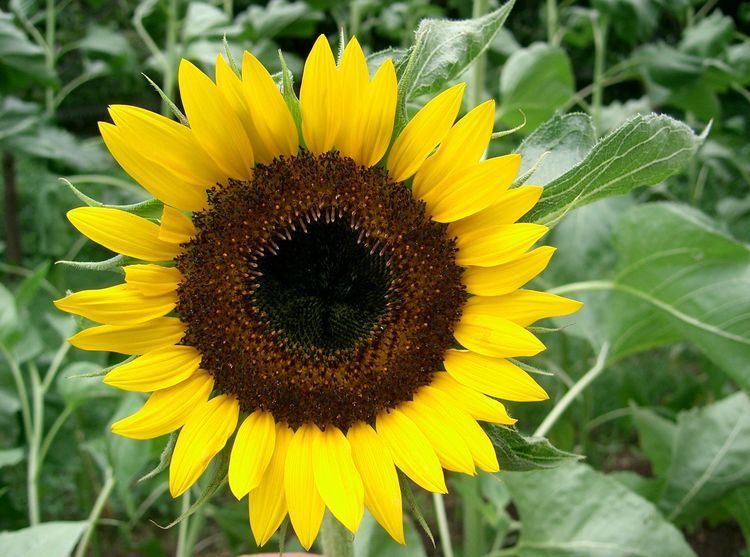
Most cultivars of sunflower are variants of Helianthus annuus, but four other species (all perennials) are also domesticated. This includes H. tuberosus, the Jerusalem Artichoke, which produces edible tubers.
Mathematical model of floret arrangement
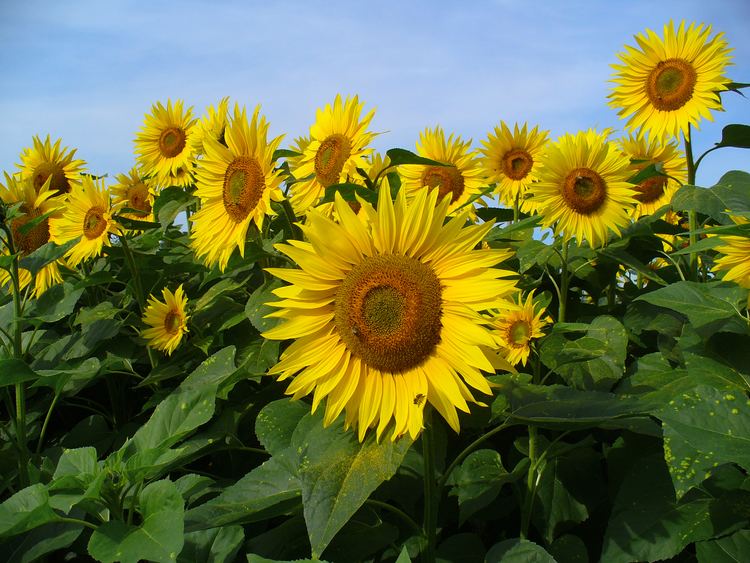
A model for the pattern of florets in the head of a sunflower was proposed by H. Vogel in 1979. This is expressed in polar coordinates
where θ is the angle, r is the radius or distance from the center, and n is the index number of the floret and c is a constant scaling factor. It is a form of Fermat's spiral. The angle 137.5° is related to the golden ratio (55/144 of a circular angle, where 55 and 144 are Fibonacci numbers) and gives a close packing of florets. This model has been used to produce computer graphics representations of sunflowers.
Genome
The sunflower, Helianthus annuus, genome is diploid with a base chromosome number of 17 and an estimated genome size of 2871–3189 Mbp. Some sources claim its true size is around 3.5 billion base pairs (slightly larger than the human genome).
Cultivation and uses
To grow best, sunflowers need full sun. They grow best in fertile, moist, well-drained soil with heavy mulch. In commercial planting, seeds are planted 45 cm (1.48 ft) apart and 2.5 cm (0.98 in) deep. Sunflower "whole seed" (fruit) are sold as a snack food, raw or after roasting in ovens, with or without salt and/or seasonings added. Sunflowers can be processed into a peanut butter alternative, sunflower butter. In Germany, it is mixed with rye flour to make Sonnenblumenkernbrot (literally: sunflower whole seed bread), which is quite popular in German-speaking Europe. It is also sold as food for birds and can be used directly in cooking and salads. American Indians had multiple uses for sunflowers in the past, such as in bread, medical ointments, dyes and body paints.
Sunflower oil, extracted from the seeds, is used for cooking, as a carrier oil and to produce margarine and biodiesel, as it is cheaper than olive oil. A range of sunflower varieties exist with differing fatty acid compositions; some 'high oleic' types contain a higher level of monounsaturated fats in their oil than even olive oil.
The cake remaining after the seeds have been processed for oil is used as a livestock feed. Some recently developed cultivars have drooping heads. These cultivars are less attractive to gardeners growing the flowers as ornamental plants, but appeal to farmers, because they reduce bird damage and losses from some plant diseases. Sunflowers also produce latex, and are the subject of experiments to improve their suitability as an alternative crop for producing nonallergenic rubber.
Traditionally, several Native American groups planted sunflowers on the north edges of their gardens as a "fourth sister" to the better known three sisters combination of corn, beans, and squash. Annual species are often planted for their allelopathic properties.
However, for commercial farmers growing commodity crops, the sunflower, like any other unwanted plant, is often considered a weed. Especially in the Midwestern US, wild (perennial) species are often found in corn and soybean fields and can have a negative impact on yields.
Sunflowers can be used in phytoremediation to extract toxic ingredients from soil, such as lead, arsenic and uranium, and used in rhizofiltration to neutralize radionuclides and other toxic ingredients and harmful bacteria from water. They were used to remove caesium-137 and strontium-90 from a nearby pond after the Chernobyl disaster, and a similar campaign was mounted in response to the Fukushima Daiichi nuclear disaster.
Heliotropism misconception
A common misconception is that flowering sunflower heads track the Sun across the sky. Although immature flower buds exhibit this behaviour, the mature flowering heads point in a fixed (and typically easterly) direction throughout the day. This old misconception was disputed in 1597 by the English botanist John Gerard, who grew sunflowers in his famous herbal garden: "[some] have reported it to turn with the Sun, the which I could never observe, although I have endeavored to find out the truth of it." The uniform alignment of sunflower heads in a field might give some people the false impression that the flowers are tracking the sun.
This alignment results from heliotropism in an earlier development stage, the bud stage, before the appearance of flower heads (anthesis). The buds are heliotropic until the end of the bud stage, and finally face East. Their apparent heliotropic motion is a circadian rhythm, synchronized by the sun, which continues if the sun disappears on cloudy days or if plants are moved to constant light. If a sunflower plant in the bud stage is rotated 180°, the bud will be turning away from the sun for a few days, as resynchronization by the sun takes time. The heliotropic motion of the bud is caused by unequal growth speed of the flower stalk and only occurs before the flowers open. The motion of the 'nodding' buds is irreversible, but cumulative. When growth of the flower stalk stops and the flower is mature, the heliotropisms also stops and the flower faces east from that moment onward. This eastward orientation allows rapid warming in the morning and, as a result, an increase in pollinator visits. Sunflowers do not have a pulvinus below their inflorescence. A pulvinus is a flexible segment in the leaf stalks (petiole) of some plant species and functions as a 'joint'. It effectuates leaf motion due to reversible changes in turgor pressure, which occurs without growth. The sensitive plant's closing leaves are a good example of reversible leaf movement via pulvinuli.
History
Although it was commonly accepted that the sunflower was first domesticated in what is now the southeastern US, roughly 5000 years ago, there is evidence that it was first domesticated in Mexico around 2600 BC. These crops were found in Tabasco, Mexico at the San Andres dig site. The earliest known examples in the United States of a fully domesticated sunflower have been found in Tennessee, and date to around 2300 BC. Many indigenous American peoples used the sunflower as the symbol of their solar deity, including the Aztecs and the Otomi of Mexico and the Incas in South America. In 1510 early Spanish explorers encountered the sunflower in the Americas and carried its seeds back to Europe. Of the four plants known to have been domesticated in what is now the eastern continental United States and to have become important agricultural commodities, the sunflower is currently the most economically important.
During the 18th century, the use of sunflower oil became very popular in Russia, particularly with members of the Russian Orthodox Church, because sunflower oil was one of the few oils that was allowed during Lent, according to some fasting traditions.
Among the Zuni people, the fresh or dried root is chewed by the medicine man before sucking venom from a snakebite and applying a poultice to the wound. This compound poultice of the root is applied with much ceremony to rattlesnake bites. Blossoms are also used ceremonially for anthropic worship.
Culture
Cultivars
The following are cultivars of sunflowers (those marked agm have gained the Royal Horticultural Society's Award of Garden Merit):-
Other species
There are many species in the sunflower genus Helianthus, and many species in other genera that may be called sunflowers.
Sunflower hybrids
In today's market, most of the sunflower seeds provided or grown by farmers are hybrids. Hybrids or hybridized sunflowers are produced by crossbreeding different types and species of sunflower, for example crossbreeding cultivated sunflowers with wild species of sunflowers. By doing so, new genetic recombinations are obtained ultimately leading to the production of new hybrid species. These hybrid species generally have a higher fitness and carry properties or characteristics that farmers look for, such as resistance to pathogens.
Threats and diseases
One of the major threats that sunflowers face today is Fusarium, a filamentous fungi that is found largely in soil and plants. It is a pathogen that over the years has caused an increasing amount of damage and loss of sunflower crops, some as extensive as 80 percent of damaged crops.
Downy mildew is another disease to which sunflowers are susceptible. Its susceptibility to downy mildew is particular high due to the sunflower's way of growth and development. Sunflower seeds are generally planted only an inch deep in the ground. When such shallow planting is done in moist and soaked earth or soil, it increases the chances of diseases such as downy mildew.
Another major threat to sunflower crops is broomrape, a parasite that attacks the root of the sunflower and causes extensive damage to sunflower crops, as high as 100 percent.
